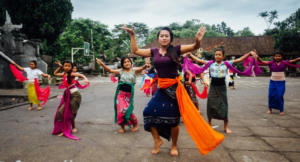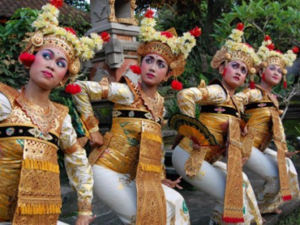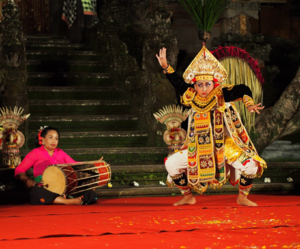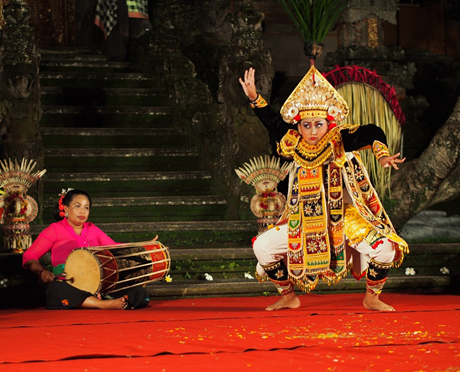Community-based Tourism (CBT) as Alternative Development in Bali
By Naomi Nelson
Introduction
Bali, like other international mass tourism locations, faces a classic tourist dilemma: tourism relies on culture, but tourism is also a threat to culture. However, Bali presents a unique approach to addressing this dilemma by using cultural performances as tourist attractions, thus allowing traditions to prosper while fostering the local arts. By self-determining what tourism means to them and their culture, the Balinese have developed a clear boundary to separate what they do for themselves from what they do for tourists, using the tourist audience as a way to preserve their social fabric and revitalize their cultural traditions. This community-based tourism (CBT) approach was codified in the Bali Master Plan following the “Seminar on Cultural Tourism in Bali” in 1971, which was convened by the regional government and Balinese agencies for tourism, religion, and culture (Picard, 1990, 42). In this way, Balinese authorities profit from a controlled tourist development while allowing the local population to participate and benefit from the tourist trade.
For example, the trademark Balinese dances serve as both tourist entertainment and creative excellence and are the epitome of artistry for locals. “In the temple we ask for a blessing, and at a hotel we ask for money” (Picard, 1990, 37). Bali’s dance is simultaneously an offering to the gods and amusement for tourists. Dance specialists are both theater and ritual savants for Balinese people, which is a different view of performing arts from that of Western culture. The renowned dances are extravagant displays of history and values experienced both by tourists and by locals, who watch or participate in the performance. The performances usually take place during dinner either in the home village of the troupes or in the international hotels where tourists are staying (Picard, 1990, 47). These dances are sometimes different from dances performed in temples for Balinese people, which serve as rituals and are not for tourist consumption. This separation allows natives to keep something for themselves, which is not the case in traditional mass tourism.
Analysis
Bali’s alternative tourism approach represents a movement away from Eurocentric political thought and modernity to benefit all members of Balinese society (Gudynas, 2011, 446). Western culture’s mass tourism is based on a quick and cheap resort experience at the expense of the environment, often presented as all-inclusive packages during the time of year most convenient for vacationers. Alternatives to traditional tourism must therefore emphasize culturally and environmentally sustainable strategies. The movement of “slow tourism,” which is exemplified by Bali’s approach to tourism, emphasizes indigenous contributions and control and is as an example of alternative, decolonial development within an intercultural environment. “Slow Tourism,” as Conway argues, “can serve as the promotional identity under which quality offerings, community-level, and local participatory initiatives, and island-specific alternative tourisms can be marketed and supported” (Conway, 339). This method promotes well-being based on moral and ethical principles that are often forgotten in more escapist approaches to tourism. Bali allows tourists to experience their culture in a slow, respectful way beyond Western modernity.
Bali’s success in developing community-based tourism can also be understood through Shamsuddina’s 2008 concept of “place attachment,” which refers to the relationship between people and places that are created through continually experiencing a specific geography. Bali’s approach to tourism provides tourists with a personal experience of Balinese culture in the physical location of their vacation, thus fostering bonds between residents and tourists. At the same time, community-based slow tourism also supports residents’ place attachment and strengthens communities’ self-governance by allowing the Balinese local communities to become active participants in framing the problems associated with tourism and developing solutions (Numbogu et al., 2018). By centering residents’ voices, self-governance through such strategies as CBT also fosters civic participation and strengthens the communities’ ability to accomplish their own goals without the government’s lead or intervention.
Blackstock explains that traditional CBT “centres on the involvement of the host community in planning and maintaining tourism development in order to create a more sustainable industry” (Blackstock, 2005, 39). Bali takes this model one step further by drawing on residents’ place attachment as a means to support their cultural identity via tourism. By using place attachment as an alternative to mass tourism, Bali creates a form of CBT that is informed by a community development ethos, which helps ensure that tourism enhances rather than destroys their communities (Blackstock, 2005, 46).
Implications
Tourism is often viewed as an opportunity to experience new places or cultures, but it can also be understood as a means of prioritizing tourists with capital over the people who live in exoticized places, and especially in small islands such as Bali. This phenomenon can be explained by David Harvey’s theory of accumulation by dispossession, which is based on Marx’s concept of primitive accumulation. Accumulation by dispossession (ABD) includes many “predatory processes that lead to loss for some and the accumulation of capital by others” (Schmid, 2015, 115). Dispossession can be defined as the lack of consent, violent appropriations of land and property, monopolistic practices, displacement, and policing of space in exchange for economic development. This theory of loss can explain the formative periods of tourism, including the mid-18th century Grand Tour Era’s elitist mobility, the mass tourism of 20th-century post-industrial revolution’s Mobility Era’s, and the current postmodern era of alternative tourism. Planning, through its colonial empirical practices, has thus played a key role in the promotion of tourism and the displacement of already marginalized small island communities.
However, tourism could be made more sustainable by decolonial approaches such as Bali’s CBT, which prioritizes self-governance, place attachment, and slow theories. Bali allows tourists to live like a local and invites them to bring those experiences home. Islands that want to plan for more sustainable tourism could use these approaches to redefine what it means to travel to another country, sustainably and respectfully without imposing a cost on local environments or indigenous identities. Community-based tourism and collective action challenge the many dispossessing power relations associated with the dominant tourist practices in urban development.

Children Learning Legong Bapang Saba Dance, Bali Indonesia by Adam Cohn. See Source Here.

“Wali” sacred dance performed by Balinese dancers. See Source Here.

Crowd of tourists surrounding Balinese performers during sunset. See Source Here.

Intergenerational Balinese performers. See Source Here.

Balinese temple. See Source Here.
